In an era of constant changes, creative thinking has become a critical ability in coping with life and enriching society. Teachers who are on the forefront of shaping minds in the future are empowered with the task of teaching knowledge as well as developing the inherent creative skills lying in each learner. However, developing one’s creativity in a meaningful manner requires more than encouraging imagination through freestyle activity or assigning open-ended tasks. It requires one to know the creative strengths and weaknesses of the learners and those aspects of their creative thinking that can be worked upon. That is where it is helpful to employ a creative test – to empower educators with systematic and meaningful methods to test and capture the diverse creative abilities of their learners.
The increasing recognition of creativity as an essential 21st-century competency, an unlocker of success in an accelerating world of technological disruption, global connectivity, and complex social problems, indicates the urgency to mainstream creativity measures in education. In a world of automation and its accompanying driver, artificial intelligence, which is reimagining industries, human capacity to solve complex problems creatively, to break out of the box, and to create new and novel ways to solve problems is highly valued. Teachers who impart their learners with these imperative creative competencies are not only equipping their learners with future occupational competencies but also with the capacity to become resilient, adaptive, and engaged members of their societies who are capable of meaningfully contributing to an uncertain and dynamic world.
Although measures of creativity create the platform needed to pursue this mandate task with accuracy and effectiveness, they open doors to develop an understanding regarding the state of creative capacity in their learners at any point in time, to track their development over a period of time, and to identify areas in which interventions with precise focus could be helpful. By adopting such measures, educators can transcend the context of anecdotal observations and create evidence-based interventions to unlock the creative capacity inherent in each learner to create an entire new world of learners who are not only knowledge-consumers but knowledge-creators and innovators who are well-positioned to create a better world.
- What Are Creativity Assessments?
- Types of Creativity Assessments
- How to Choose The Ideal Creativity Assessment Tool?
- Top 7 Creativity Assessment Methods for Educator
- How to Make An Engaging Creativity Assessment with OnlineExamMaker?
- Frequently Asked Questions about Creativity Assessments
What Are Creativity Assessments?
Measures of creativity are systematic measures that are used to quantify an individual’s ability to generate new, valuable, and contextually relevant ideas or solutions. For the education sector, these measures are valuable instruments to understand the creative potential of one’s students, their strengths and weaknesses in various aspects of creativity, and subsequently utilize this to direct instructional strategies to develop their emerging creativity. Contrary to conventional measures that put enormous emphasis on convergent thinking – the process of arriving at one correct answer – creativity measures focus on inquiring into divergent thinking (ability to generate a lot of different possibilities), problem-solving skill, novelty, amount of ideas generated (fluency), and depth and richness of conceptual elaboration.
The significance of creativity in education cannot be overstated. With rapid technological advancements in a world of instant global connectivity and ever-changing societal agendas, the ability to be creative, to readily accept new situations and embrace them with flexibility, and to envision new resolutions has transcended the levels of what is desirable to become an indispensable competence to succeed in all realms of life. Creativity measures equip educators with in-depth knowledge that transcends the standard measures of cognitive functionality to let them develop an enriched understanding of their students’ natural abilities and actively encourage their emerging creative strengths.
Types of Creativity Assessments
Creativity testing has a rich diversity of methodologies that are all precisely designed to tap different facets of creative thought and action. Creativity measures can be classified broadly into a set of primary categories with distinct strengths and weaknesses and different levels of applicability in instructional situations:
Divergent Thinking Tests
These assess the ability to generate multiple and varied ideas in response to an open-ended prompt, focusing on fluency, flexibility, originality, and elaboration. Examples include the Torrance Tests of Creative Thinking (TTCT) and Guilford’s Alternative Uses Task (AUT).
Problem-solving Tasks
These are ill-structured problems with potentially creative solutions, assessing insight, flexibility of thinking, the capacity to overcome the tendency of functional fixedness, and the effectiveness and novelty of the solution. Design problems and the Remote Associates Test (RAT) are included in this category.
Visual and Figural Tests
Utilizing visual stimuli, these measures test creative skills through drawing completion or abstract shape interpretation, assessing visual fluency, originality, elaboration, and abstractness of titles.
Self-Report Questionnaires and Inventories: These utilize respondents’ own descriptions of their creative abilities, their process activities specific to the task, and their creative attitudes, often asking questions on novelty preferences, risk taking propensity, and imagination. Some measures are the Creative Personality Scale.
Performance-Based Assessments
They examine creativity in terms of performance or end-product in real life, such as the painting, writing samples, or the projects themselves, and generally by employing rubrics to measure originality and novelty.
How to Choose The Ideal Creativity Assessment Tool?
Selection of an effective creative abilities measuring instrument is an important one to be undertaken by educators in an attempt to effectively know and cultivate the creative capacities of their learners. With such a vast array of instruments to select from, systematic and careful consideration of a variety of key factors should be done in order to be sure that the measure to be selected maps on to wider learning intentions and yields significant and actionable information.
Teachers should normally set their intent and purpose clearly, take careful thought regarding the developmental period and age of their learners, clearly indicate the precise areas of creativity to be measured, fully take into consideration the practicality and implementability in their own context, examine the test-retest reliability and validity of the measure, clearly understand the scoring process and process of interpretation, consider the nature of the resultant feedback and readability of findings, and investigate the issue of support resources and technical support.
By taking painstaking care to consider each of these salient factors in turn, educators are ultimately in a position to make informed choices and strategically select the measures of creative abilities best suited to their specific learning demands, the developmental profiles of their learners, and their wider aspirations to foster an environment in their classrooms that is even more inquiring and creative.
OnlineExamMaker: Best Online Creativity Assessment Software for You
OnlineExamMaker is an interactive online quiz platform that, while not exclusively designed for creativity assessments, can be effectively adapted to evaluate and foster creative thinking in educational settings. Its versatility in creating engaging, real-time activities like quizzes, games, and open-ended questions.
Key Features for Creativity Assessment
Open-Ended Questions: Create essay questions that allow student to answer flexibly, it is ideal for evaluating elaboration and flexibility.
Real-Time Feedback: Responses are displayed instantly, allowing educators to assess creativity on the spot and spark discussions based on unique or divergent ideas.
Quiz and Gamification: Competitive quizzes can include creative prompts, with leaderboards to motivate engagement.
Data Analytics: Detailed results (exportable) allow educators to analyze response patterns for creativity metrics, such as the diversity of ideas.
Mobile Accessibility: Students can join the assessment via smartphones or computers using a code or QR code, ensuring broad access.
Create Your Next Quiz/Exam with OnlineExamMaker
Top 7 Creativity Assessment Methods for Educator
- 1. Torrance Tests of Creative Thinking
- 2. Creativity Assessment Packet
- 3. Rubrics for Project-Based Learning
- 4. Formative Assessment Strategies
- 5. Digital Tools for Creative Assessments
- 6. Self and Peer Assessment Tools
- 7. Creative Teaching and Learning Graphic Equaliser
Here are some effective creativity assessment tools and strategies tailored for educators to evaluate and foster creative thinking in students, based on established methods and practical classroom applications:
1. Torrance Tests of Creative Thinking (TTCT)
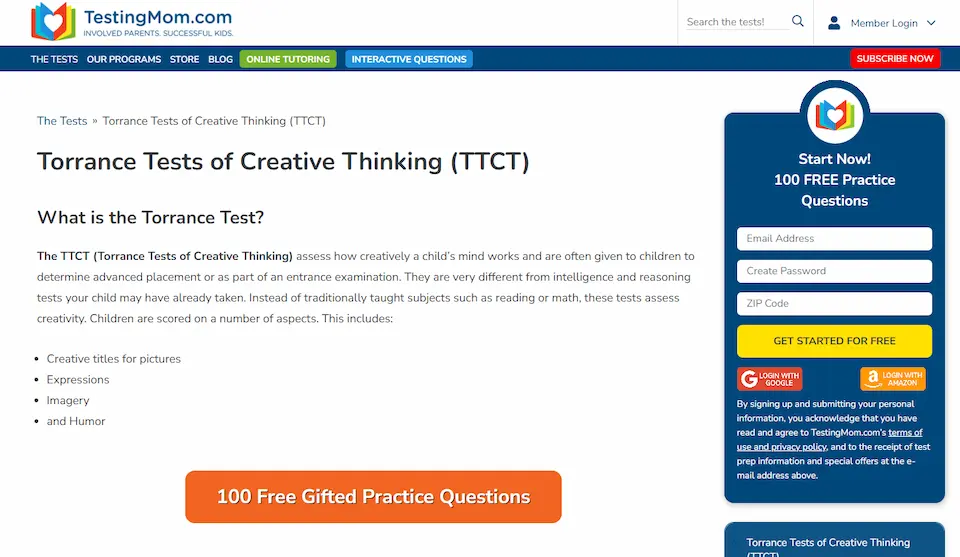
Description: Developed by E. Paul Torrance, the TTCT is one of the most widely used and researched tools for assessing creativity. It includes verbal and figural components, measuring four key aspects: fluency (number of ideas), originality (uniqueness of ideas), elaboration (detail in responses), and flexibility (variety of perspectives).
How It Works:
Verbal tasks: Students generate multiple uses for common objects or respond to hypothetical scenarios.
Figural tasks: Students complete unfinished drawings or create images from shapes.
Use in Education: Suitable for identifying creative potential in students of all ages. It’s often used in gifted programs or to tailor creative instruction.
Considerations: Requires training for administration and scoring, and educators should ensure cultural sensitivity when applying it.
Access: Available through educational psychology services or testing providers like Scholastic Testing Service.
2. Creativity Assessment Packet (CAP)
Description: A lesser-known but practical tool, the CAP evaluates divergent thinking through tasks like generating alternative solutions to problems or creating stories.
How It Works: Students complete open-ended tasks, and responses are scored for creativity based on novelty and appropriateness.
Use in Education: Ideal for classroom settings where educators want to assess creativity without extensive training. It’s flexible for various age groups.
Considerations: Less standardized than TTCT but more accessible for classroom use. Check for validity and reliability when selecting versions.
3. Rubrics for Project-Based Learning (PBL)
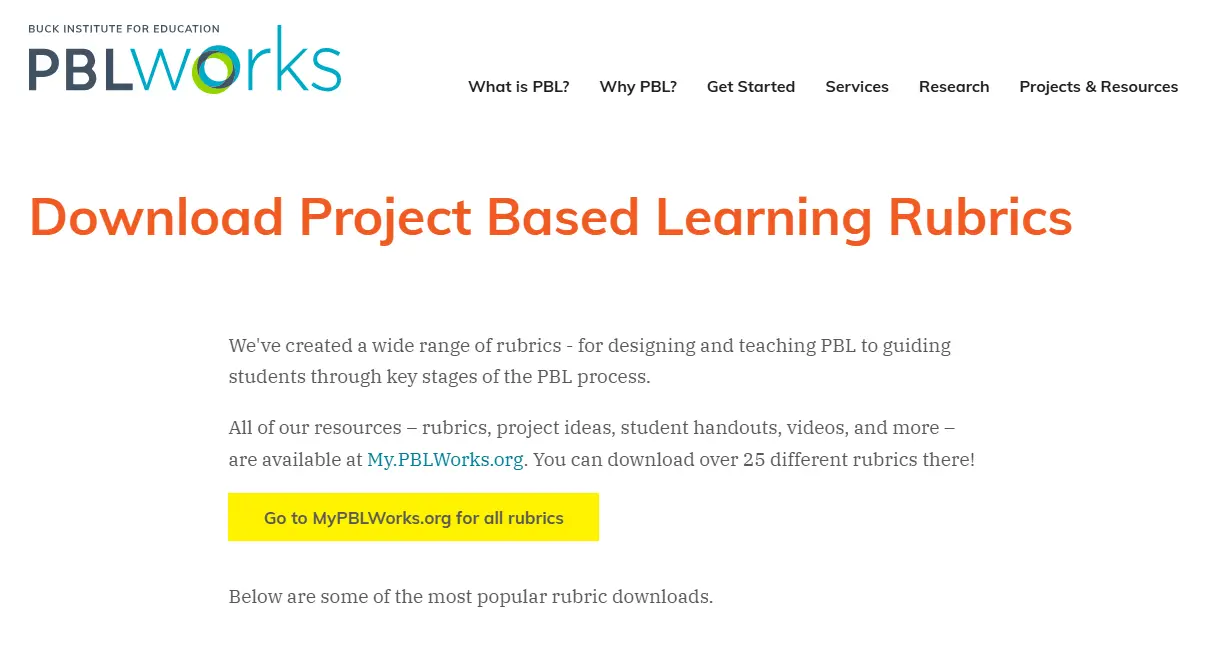
Description: Rubrics designed for PBL projects can include creativity as a scored component, focusing on quality indicators like novelty, problem-solving, and risk-taking.
How It Works: Educators create or adapt rubrics with criteria such as:
Novelty: Does the project present a unique perspective or solution?
Synthesis: Does it combine ideas in unexpected ways?
Use in Education: Practical for assessing creativity within existing assignments, such as science fairs, art projects, or interdisciplinary tasks. Edutopia suggests aligning rubrics with age-appropriate indicators to make expectations clear.
Considerations: Define creativity clearly to avoid subjective grading. Involve students in co-creating rubrics to reduce risk-aversion.
4. Formative Assessment Strategies with Creative Elements
Description: These are short, gradeless activities to gauge creativity during the learning process, encouraging students to think divergently.
Examples:
Sketchnoting: Students create visual representations of concepts, enhancing recall and creative expression.
Comic Strips: Using tools like Canva, students create comics to explain concepts, blending narrative and visuals.
Mini TED Talks: Students present a lesson idea in a creative, persuasive format.
Write a Letter: Students explain a concept in a letter to a fictional audience, encouraging novel framing.
Use in Education: These quick checks foster creativity while providing insights into student understanding. They’re ideal for daily classroom use.
Considerations: Provide immediate feedback and time to refine skills to maximize learning. Ensure tasks align with learning objectives.
5. Digital Tools for Creative Assessments
Description: Technology platforms can support interactive and creative assessments, often integrating real-time feedback and collaboration.
Examples:
Kahoot!: Create quizzes with open-ended questions that reward creative responses. Free for basic use, with premium plans for advanced features.
Mentimeter: An interactive tool for polls, quizzes, and open-ended questions that encourage creative input. Basic plan is $8.99/month for educators.
Padlet: A collaborative canvas for students to post ideas, images, or sketches, fostering brainstorming and reflection.
TeacherMade: Convert existing materials into online assessments with creative response options. Free basic account available.
Use in Education: These tools engage tech-savvy students and streamline grading. They’re versatile for formative or summative assessments.
Considerations: Ensure tools are accessible to all students and comply with data privacy regulations.
6. Self and Peer Assessment Tools
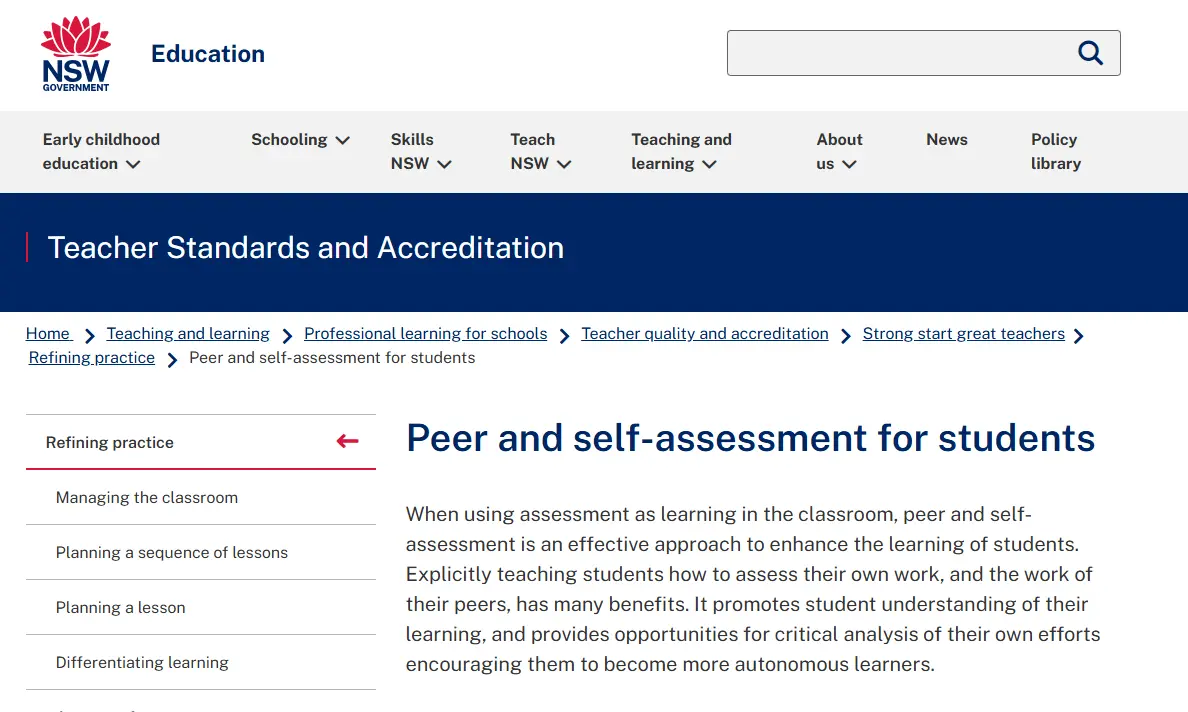
Description: Encourage students to reflect on their creative process or evaluate peers’ work, fostering metacognition and critical thinking.
How It Works:
Reflective Journals: Students document their creative process (e.g., via video or written logs), describing challenges and insights.
Creativity Skills Spider Diagram: A tool from Education Scotland where students rate their creativity skills (e.g., risk-taking, collaboration) and discuss progress.
Peer Feedback Platforms: Tools like Floop allow students to give annotated feedback on creative projects.
Use in Education: Builds student ownership of creativity and reduces reliance on teacher judgment. Ideal for long-term projects.
Considerations: Provide clear guidelines to ensure constructive feedback and avoid bias.
7. Creative Teaching and Learning Graphic Equaliser
Description: A tool from Scotland’s National Improvement Hub to assess the creativity of the learning environment itself, not just student output.
How It Works: Educators and students use a visual “equalizer” to rate aspects like risk-taking, collaboration, and spontaneity in the classroom.
Use in Education: Helps teachers reflect on how their environment nurtures creativity, informing instructional adjustments.
Considerations: Best used as a planning tool alongside student-focused assessments.
How to Make An Engaging Creativity Assessment with OnlineExamMaker?
It is often tricky to evaluate this frequently slippery quality, yet OnlineExamMaker provides a strong platform to create stimulating creativity tests beyond rote learning. With its varied features, educators and employers can efficiently measure creative thinking and solve problems effectively.
OnlineExamMaker gives you the power to break away from conventional multiple-choice questions. Add open-response essay items that enable applicants to express themselves and share their individual views. Use picture and video response questions to test visual thinking and narrative skills. You can even use scenario-based questions that challenge people to exercise their imagination to solve real-life problems.
Create Your Next Quiz/Exam with OnlineExamMaker
Here’s 4 steps of making easy creativity assessment:
Step 1: Identify creativity focus
Establishing a clear definition of what areas of creativity to test is essential before embarking on question construction. Do you seek originality, idea fluency, flexibility in thinking or solving problems? A well-established focus will guide your question construction to ensure the test reflects your purpose.
Step 2: Embrace multiple types of questions
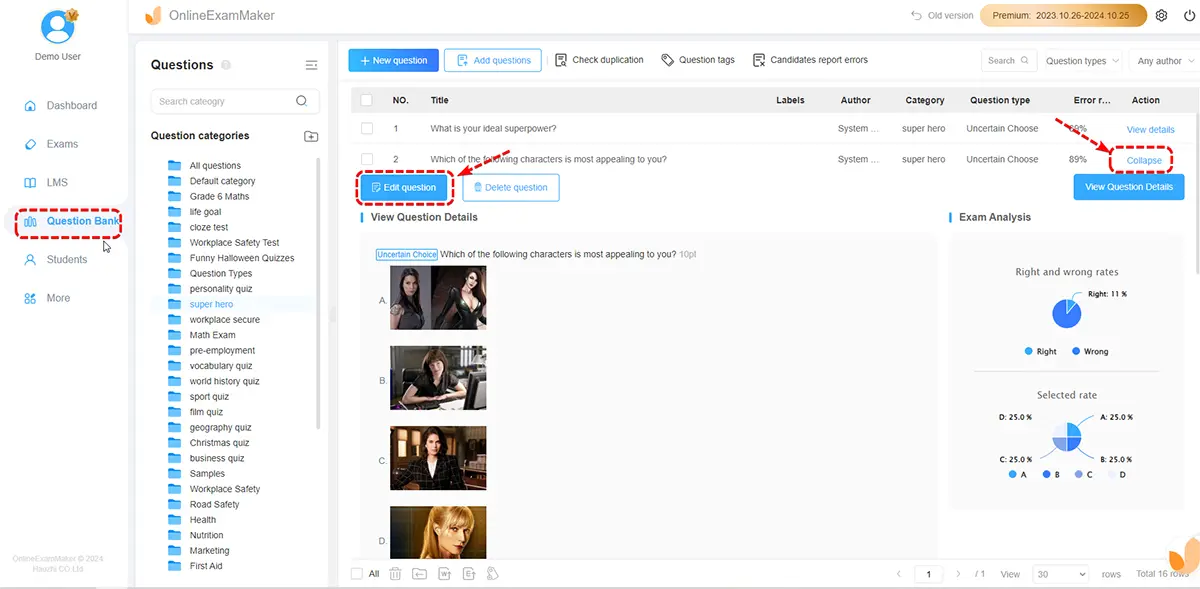
Move away from the constraints of question formats with a single answer. OnlineExamMaker lets you include multiple question types like essay questions with elaborate explanations, subjective questions with room for varied responses, and even file-upload questions with the submission of creative content like designs or presentations.
Step 3: Integrate multimedia elements
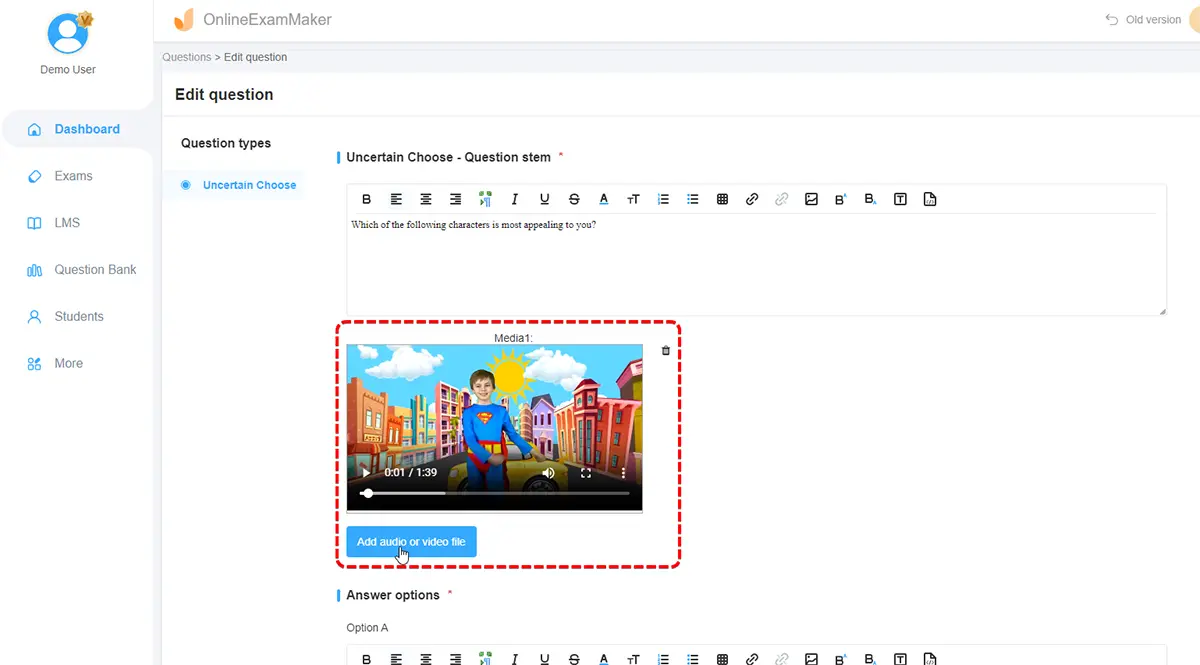
Add life to your test by inserting images, videos, and audio tracks. Provide visual stimuli to be interpreted creatively, require an analysis of multimedia material from a new angle of thought, or encourage candidates to extend the ideas presented in creative content.
Step 4: Use randomization and time limits
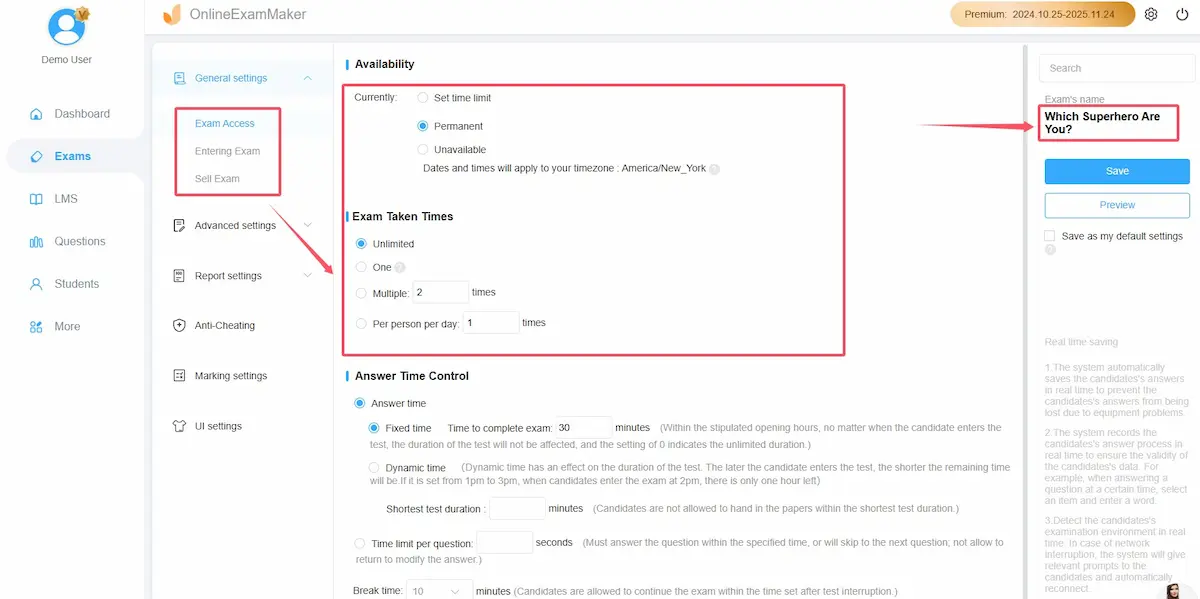
To promote out-of-the-box thinking and minimize copying from elsewhere, take advantage of OnlineExamMaker’s question and option randomization capabilities. Applying suitable time limits on each section can also simulate real-life pressure and evaluate the creative problem-solving speed and efficiency.
Step 5: Publish and share your creativity assessment
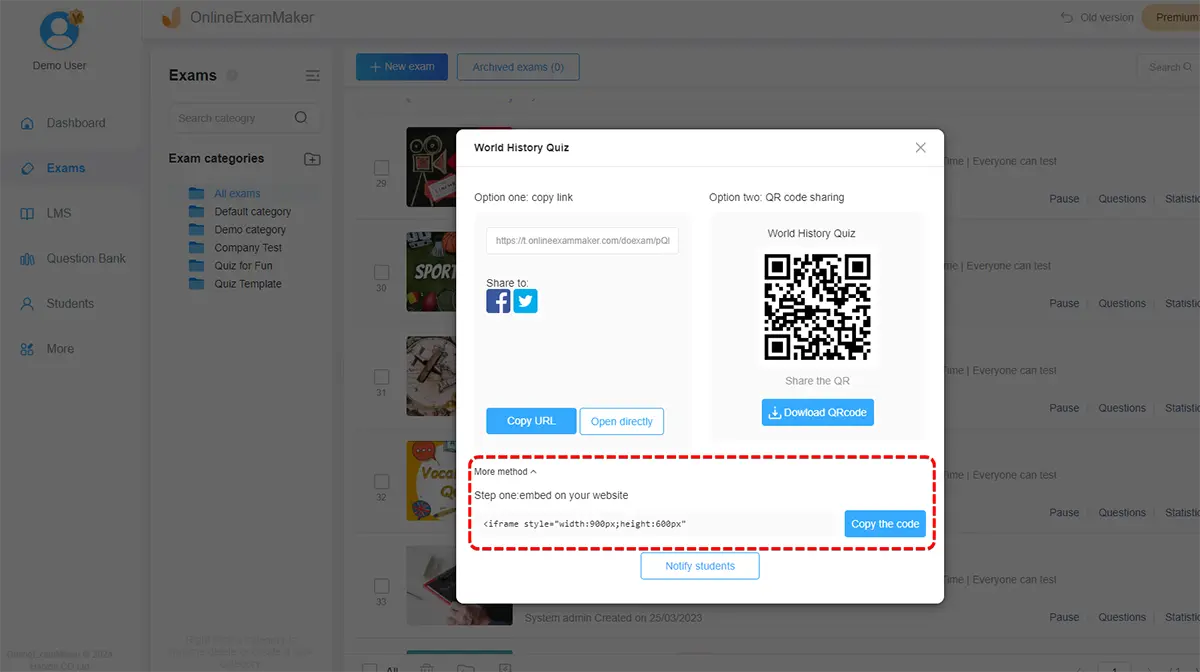
After you configure the exam settings, it is time to save the settings and preview it on your own computer. If you are satisfied with the assessment, you can click the “Publish” button to release it.
After the assessment is published, you get a direct link and QR code instantly. You can share the link or QR code to you candidates via email or message.
Following these steps and digging into the comprehensive capabilities of OnlineExamMaker, it is possible to create inventive assessments that are not only enlightening but also stimulating and reflective of authentic innovative potential. Go beyond testing knowledge and begin to discover the creative potential in your applicants.
Frequently Asked Questions about Creativity Assessments
What are the benefits of using creativity assessment software?
Efficiency: Digital platforms like the CTC offer faster, cost-effective testing compared to manual, paper-based methods.
Accessibility: Web-based and non-verbal tests (e.g., CTC) support diverse populations, including low socio-economic or non-English-speaking groups.
Scalability: Suitable for large groups, unlike traditional tests that are time-intensive to score.
Development: Provides insights to tailor training or curriculum to enhance creativity.
Equity: Identifies hidden talents that standard intelligence tests may miss.
What are common features of creativity assessment software?
Open-ended tasks (for example, essays, drawings, or multimedia projects).
Automated scoring with AI or machine learning.
Customizable rubrics for fair evaluation.
Gamified formats to engage users.
Analytics and reports to compare results or track progress.
Multi-language and culture-independent options for broader accessibility.
Are there free creativity assessment tools available?
Yes, some platforms offer free versions or trials. For example:
TestMyCreativity: A free online test measuring eight creativity metrics.
OnlineExamMaker: Offers a free account for creating assessments, though premium features may require payment.
Renzulli Learning: Includes the CTC at no extra cost with a user license ($15 per user).
Can creativity assessment software improve creativity?
While primarily for measurement, many tools provide feedback or link to development activities. For example, Renzulli Learning pairs the CTC with personalized creativity exercises, and platforms like TAO offer strategies to enhance creative thinking through multimedia tasks. Regular use with reflective feedback can help users build creative skills.
What are emerging trends in creativity assessment software?
AI Integration: Machine learning improves scoring speed and accuracy (e.g., TCT-DP’s automated scoring).
Gamification: Interactive formats like Kahoot! make assessments engaging.
Multimedia: Tools allow video, art, or infographic submissions to capture diverse creative outputs.
Adaptive Testing: AI-driven platforms adjust task difficulty based on user responses.